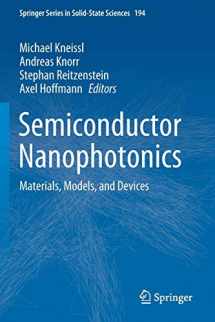
Semiconductor Nanophotonics: Materials, Models, and Devices (Springer Series in Solid-State Sciences, 194)
Book details
Summary
Description
This book provides a comprehensive overview of the state-of-the-art in the development of semiconductor nanostructures and nanophotonic devices. It covers epitaxial growth processes for GaAs- and GaN-based quantum dots and quantum wells, describes the fundamental optical, electronic, and vibronic properties of nanomaterials, and addresses the design and realization of various nanophotonic devices. These include energy-efficient and high-speed vertical cavity surface emitting lasers (VCSELs) and ultra-small metal-cavity nano-lasers for applications in multi-terabus systems; silicon photonic I/O engines based on the hybrid integration of VCSELs for highly efficient chip-to-chip communication; electrically driven quantum key systems based on q-bit and entangled photon emitters and their implementation in real information networks; and AlGaN-based deep UV laser diodes for applications in medical diagnostics, gas sensing, spectroscopy, and 3D printing.
The experimental results are accompanied by reviews of theoretical models that describe nanophotonic devices and their base materials. The book details how optical transitions in the active materials, such as semiconductor quantum dots and quantum wells, can be described using a quantum approach to the dynamics of solid-state electrons under quantum confinement and their interaction with phonons, as well as their external pumping by electrical currents. With its broad and detailed scope, this book is indeed a cutting-edge resource for researchers, engineers and graduate-level students in the area of semiconductor materials, optoelectronic devices and photonic systems.
From the Back Cover
This book provides a comprehensive overview of the state-of-the-art in the development of semiconductor nanostructures and nanophotonic devices. It covers epitaxial growth processes for GaAs- and GaN-based quantum dots and quantum wells, describes the fundamental optical, electronic, and vibronic properties of nanomaterials, and addresses the design and realization of various nanophotonic devices. These include energy-efficient and high-speed vertical cavity surface emitting lasers (VCSELs) and ultra-small metal-cavity nano-lasers for applications in multi-terabus systems; silicon photonic I/O engines based on the hybrid integration of VCSELs for highly efficient chip-to-chip communication; electrically driven quantum key systems based on q-bit and entangled photon emitters and their implementation in real information networks; and AlGaN-based deep UV laser diodes for applications in medical diagnostics, gas sensing, spectroscopy, and 3D printing.
The experimental results are accompanied by reviews of theoretical models that describe nanophotonic devices and their base materials. The book details how optical transitions in the active materials, such as semiconductor quantum dots and quantum wells, can be described using a quantum approach to the dynamics of solid-state electrons under quantum confinement and their interaction with phonons, as well as their external pumping by electrical currents. With its broad and detailed scope, this book is indeed a cutting-edge resource for researchers, engineers and graduate-level students in the area of semiconductor materials, optoelectronic devices and photonic systems.


We would LOVE it if you could help us and other readers by reviewing the book
Book review



